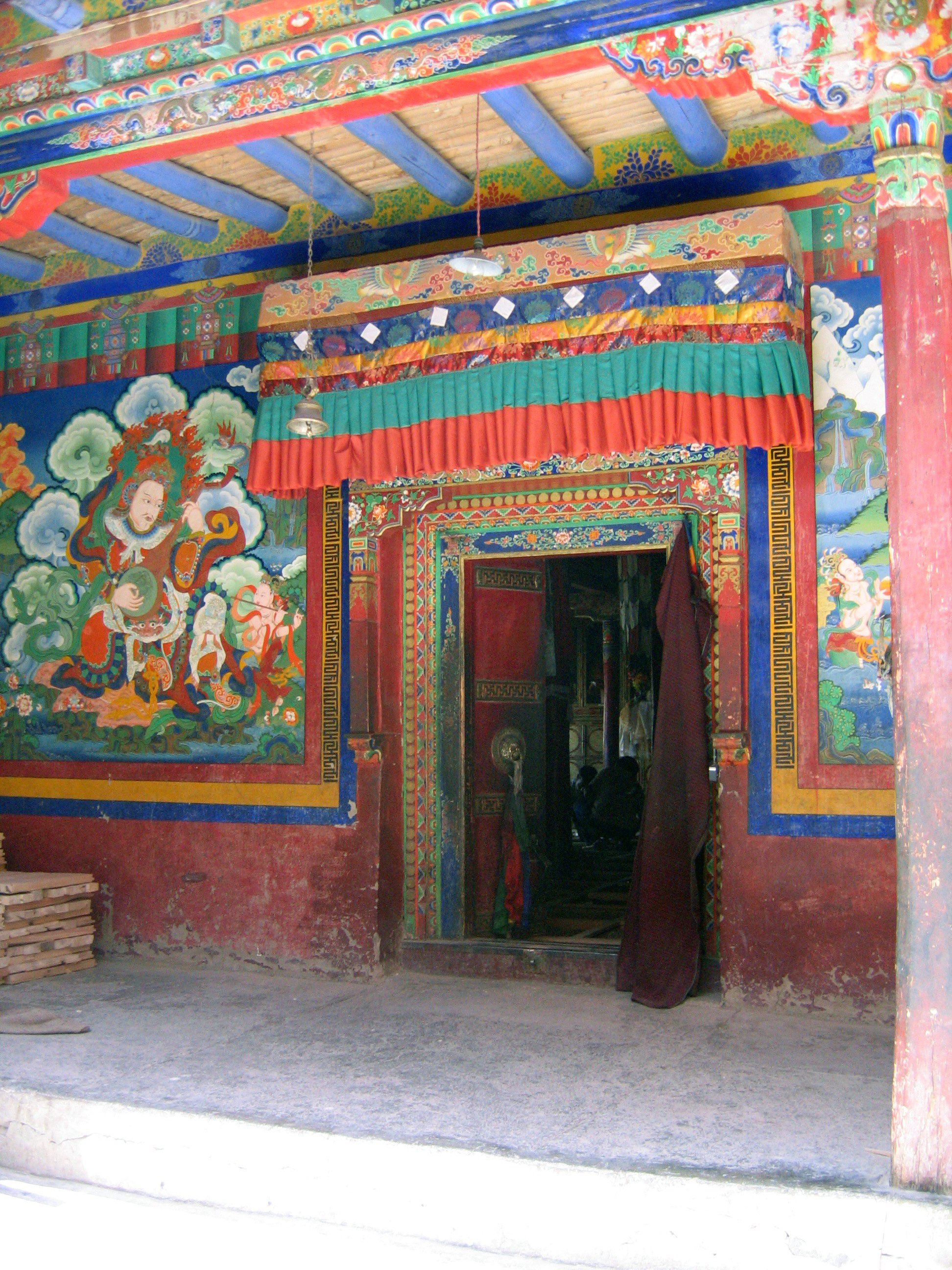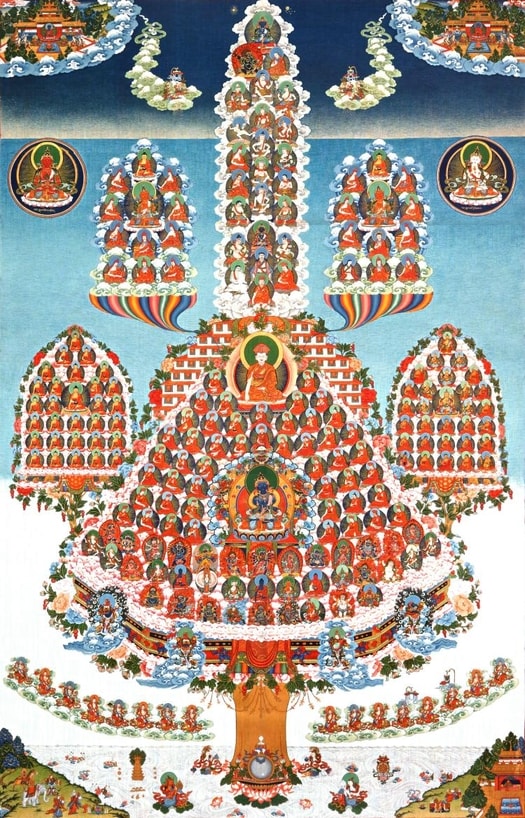|
Lamayuru Monastery
Lamayuru or Yuru Monastery ( "Eternal Monastery") is a Tibetan Buddhist monastery in Lamayouro, Leh district, Ladakh, India. It is situated on the Srinagar-Leh highway east of the Fotu La at a height of . History A. H. Francke states that, "according to popular tradition," it was originally the foremost Bon monastery in Ladakh; its name means sauwastika and is a popular symbol in Bon for "eternity". Yungdrung is the name of the most popular school of Bon. It is currently affiliated with the Drikung Kagyu school of Buddhism. The Drikung history states that the Indian scholar Naropa (956-1041 CE) allegedly caused a lake which filled the valley to dry up and founded Lamayuru Monastery. The oldest surviving building at Lamayuru is a temple called Seng-ge-sgang, at the southern end of the Lamayuru rock, which is attributed to the famous builder-monk Rinchen Zangpo (958-1055 CE). Rinchen Zangpo was charged by the king of Ladakh to build 108 gompas, and certainly many gompas in Lad ... [...More Info...] [...Related Items...] OR: [Wikipedia] [Google] [Baidu] |
Lamayouro
Lamayouro (also known as Lamayuru) is a village in the Leh district of Ladakh, India. The Lamayuru Monastery is located nearby. It is located in the Khalsi tehsil. The region is also referred to as ‘Moon Land’, due to its terrains resemblance to the surface of the Moon. Demographics According to the 2011 census of India The 2011 Census of India or the 15th Indian Census was conducted in two phases, house listing and population enumeration. The House listing phase began on 1 April 2010 and involved the collection of information about all buildings. Information ..., Lamayouro has 117 households. The effective literacy rate (i.e. the literacy rate of population excluding children aged 6 and below) is 71.93%. References {{Leh district Villages in Khalsi tehsil ... [...More Info...] [...Related Items...] OR: [Wikipedia] [Google] [Baidu] |
Sauwastika
The swastika (卐 or 卍) is an ancient religious and cultural symbol, predominantly in various Eurasian, as well as some African and American cultures, now also widely recognized for its appropriation by the Nazi Party and by neo-Nazis. It continues to be used as a symbol of divinity and spirituality in Indian religions, including Hinduism, Buddhism, and Jainism. It generally takes the form of a cross, the arms of which are of equal length and perpendicular to the adjacent arms, each bent midway at a right angle. The word ''swastika'' comes from sa, स्वस्तिक, svastika, meaning "conducive to well-being". In Hinduism, the right-facing symbol (clockwise) () is called ', symbolizing ("sun"), prosperity and good luck, while the left-facing symbol (counter-clockwise) () is called ''sauwastika'', symbolising night or tantric aspects of Kali. In Jain symbolism, it represents Suparshvanathathe seventh of 24 Tirthankaras ( spiritual teachers and savio ... [...More Info...] [...Related Items...] OR: [Wikipedia] [Google] [Baidu] |
Drikung Kagyu Monasteries And Temples
Drikung Kagyü or Drigung Kagyü ( Wylie: 'bri-gung bka'-brgyud) is one of the eight "minor" lineages of the Kagyu school of Tibetan Buddhism. "Major" here refers to those Kagyü lineages founded by the immediate disciples of Gampopa (1079-1153) while "minor" refers to all the lineages founded by disciples of Gampopa's main disciple, Phagmo Drupa (1110-1170). One of these disciples, Jigten Sumgön (1143-1217), is the founder of Drikung. History Like with all other Kagyu lineages, origins of Drikung Kagyü can be traced back to the Great Indian Master Tilopa who passed on his teachings to Mahasiddha Naropa who lived around 10th and 11th century. The founder of the Drikung Kagyü lineage was Jigten Sumgön (1143-1217) of the Kyura clan, who was the disciple of Phagmo Drupa. According to historical account from the time, Jigten Sumgön's teachings attracted more than 100,000 people at a time, with the highest number of attendance recorded at 130,000. Several sub-schools branche ... [...More Info...] [...Related Items...] OR: [Wikipedia] [Google] [Baidu] |
Wanla Monastery
Wanla Gompa is a historic Buddhist monastery on the ridge that crowns Wanla village in Ladakh, India. Its small but impressively preserved three-storeyed Avalokitesvara temple is one of the earliest known Drigung Kagyu prayer chambers to have survived in Ladakh. Wanla is a sub-monastery of Lamayuru, which provides a caretaker monk responsible for daily rituals and for granting access to the temple. The main image features Avalokitesvara in 11-headed ("Chuchigzhel") form. Along with a 1980s side building the monastery sits within the sparse remnants of a medieval castle whose construction is mentioned in Ladakhi chronicles as being by the Ladakhi King Lhachen Ngaglug (lHa-chen Ngag-lug), i.e. probably in the 12th century. The monastery was added in the heart of the castle in the 14th century. This timing adds to academic interest in Wanla since, as some writers have described, this was "an otherwise completely obscure period of Ladakh's history between the foundation of the ... [...More Info...] [...Related Items...] OR: [Wikipedia] [Google] [Baidu] |
Alchi
Alchi is a village in the Leh district of Ladakh, India. It is located in the Likir tehsil, on the banks of the Indus River 70 km downstream from the capital Leh. Unlike the other gompas in Ladakh, Alchi is situated on lowland, not on a hilltop. The Alchi Monastery or Alchi Gompa lies about 65 km from Leh on the banks of the Indus River. History The village is famous for the existence of one of the oldest monasteries in Ladakh (a national heritage) Alchi Monastery, mainly known for its magnificent and well-preserved 11th- or 12th-century wall paintings, all in an Indo- Himalayan style.Rizvi (1996), p. 60. The monastery houses thousands of rare and unique sculptures and paintings back to 11th century Western Tibet. Demographics According to the 2011 census of India, Alchi has 145 households. The effective literacy rate (i.e. the literacy rate of population excluding children aged 6 and below) is 72.51%. Image of Kannon in Ladakh 001.jpg, Image of Tara (Buddhism) in Lada ... [...More Info...] [...Related Items...] OR: [Wikipedia] [Google] [Baidu] |
Spiti Valley
Spiti (pronounced as Piti in Bhoti language) is a high-altitude region of the Himalayas, located in the north-eastern part of the northern Indian state of Himachal Pradesh. The name "Spiti" means "The middle land", i.e. the land between Tibet and India. Spiti incorporates mainly the valley of the Spiti River, and the valleys of several rivers that feed into the Spiti River. Some of the prominent side-valleys in Spiti are the Pin valley and the Lingti valley. Spiti is bordered on the east by Tibet, on the north by Ladakh, on the west and southwest by Lahaul, on the south by Kullu, and on the southeast by Kinnaur. The valley and its surrounding regions are among the least populated regions of India. Spiti has a cold desert environment. The Bhoti-speaking local population follows Tibetan Buddhism. Administration Spiti forms one of the two sub-divisions of the Lahaul and Spiti district of Himachal Pradesh, the other one being the Lahaul sub-division. The sub-divisional headqua ... [...More Info...] [...Related Items...] OR: [Wikipedia] [Google] [Baidu] |
Rinchen Zangpo
__NOTOC__ Lochen Rinchen Zangpo (958–1055; ), also known as Mahaguru, was a principal lotsawa or translator of Sanskrit Buddhist texts into Tibetan during the second diffusion of Buddhism in Tibet, variously called the New Translation School, New Mantra School or New Tantra Tradition School. He was a student of the famous Indian master, Atisha. His associates included (Locheng) Legpai Sherab. Zangpo's disciple Guge Kyithangpa Yeshepal wrote Zangpo's biography.Roberto Vitali, in McKay 2003, pp. 71-72 He is said to have built over one hundred monasteries in Western Tibet, including the famous Tabo Monastery in Spiti, Himachal Pradesh, Poo in Kinnaur and Rinchenling monastery in Nepal. Rinchen Zangpo had been sent as a young man by King Yeshe-Ö, the ruler of Zanskar, Guge, Spiti and Kinnaur, with other young scholars to Kashmir Kashmir () is the northernmost geographical region of the Indian subcontinent. Until the mid-19th century, the term "Kashmir" denoted on ... [...More Info...] [...Related Items...] OR: [Wikipedia] [Google] [Baidu] |
Leh District
Leh district is a district in the union territory of Ladakh, India. With an area of 45,110 ''km''''2'', it is the second largest district in the country smaller only to Kutch. It is bounded on the north by Gilgit-Baltistan's Kharmang and Ghanche districts and Xinjiang's Kashgar Prefecture and Hotan Prefecture linked via the historic Karakoram Pass. It has Aksai Chin and Tibet are to the east, Kargil district to the west, and Lahul and Spiti to the south. The district headquarters is in Leh. It lies between 32 to 36 degree north latitude and 75 to 80 degree east longitude. The whole of Ladakh was under the administration of Leh until 1 July 1979, when the Kargil and Leh administrative districts were created. Religion has been a source of grievances between Buddhists and Muslims since the late 20th century and was a contributor to this division. In 2017, the district was declared a tobacco-free zone. The Directorate of Health Services Kashmir under the National Tobacco C ... [...More Info...] [...Related Items...] OR: [Wikipedia] [Google] [Baidu] |
Fotu La
, photo = Fotu.La.01.jpg , photo_caption = Fotu La , map = India Ladakh#India , map_caption = Location of Fotu La in Ladakh , elevation_m = 4108 , elevation_ref = , traversed = Srinagar-Leh highway , location = Ladakh, India , range = Himalaya, Ladakh Range , coordinates = , topo = Fotu La ( hi, script=Latn, fōtu lā) or Fatu La is a mountain pass on the Srinagar-Leh highway in the Zanskar Range of the Himalayas in India. At an elevation of , it is the highest point on the highway, surpassing the famed Zoji La. Fotu La is one of two high mountain passes between Leh and Kargil, the other being Namika La. Moving eastwards, the highway begins to descend towards the Lamayuru after Fotu La. There is a Prasar Bharati Prasar Bharati (abbreviated as PB; Hindi: ''Praśar Bharati'', lit. Indian Broadcaster) is India's State media, state-owned public broadcaster, headquartered in New Delhi. It is a Statutory corporation, statutory autonomous body set up by an A ... t ... [...More Info...] [...Related Items...] OR: [Wikipedia] [Google] [Baidu] |
Srinagar
Srinagar (English: , ) is the largest city and the summer capital of Jammu and Kashmir, India. It lies in the Kashmir Valley on the banks of the Jhelum River, a tributary of the Indus, and Dal and Anchar lakes. The city is known for its natural environment, gardens, waterfronts and houseboats. It is known for traditional Kashmiri handicrafts like the Kashmir shawl (made of pashmina and cashmere wool), and also dried fruits. It is the 31st-most populous city in India, the northernmost city in India to have over one million people, and the second-largest metropolitan area in the Himalayas (after Kathmandu, Nepal). Origin of name The earliest records, such as Kalhana's ''Rajatarangini'', mentions the Sanskrit name ''shri-nagara'' which have been interpreted distinctively by scholars in two ways: one being ''sūrya-nagar'', meaning "''City of the Surya''" (trans) ''"City of Sun''" and other being ''"The city of "Shri''" (श्री), the Hindu goddess of wealth, meaning "' ... [...More Info...] [...Related Items...] OR: [Wikipedia] [Google] [Baidu] |

.png)

.jpg)


